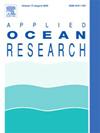Modelling the hydrodynamic response of a floating offshore wind turbine – a comparative study
IF 4.3
2区 工程技术
Q1 ENGINEERING, OCEAN
引用次数: 0
Abstract
This paper summarises the work conducted within the 1st FOWT (Floating Offshore Wind Turbine) Comparative Study organised by the EPSRC (UK) ‘Extreme loading on FOWTs under complex environmental conditions’ and ‘Collaborative computational project on wave structure interaction (CCP-WSI)’ projects. The hydrodynamic response of a FOWT support structure is simulated with a range of numerical models based on potential theory, Morison equation, Navier-Stokes solvers and hybrid methods coupling different flow solvers. A series of load cases including the static equilibrium tests, free decay tests, operational and extreme focused wave cases are considered for the UMaine VolturnUS-S semi-submersible platform, and the results from 17 contributions are analysed and compared with each other and against the experimental data from a 1:70 scale model test performed in the COAST Laboratory Ocean Basin at the University of Plymouth. It is shown that most numerical models can predict similar results for the heave response, but significant discrepancies exist in the prediction of the surge and pitch responses as well as the mooring line loads. For the extreme focused wave case, while both Navier–Stokes and potential flow base models tend to produce larger errors in terms of the root mean squared error than the operational focused wave case, the Navier-Stokes based models generally perform better. Given the fact that variations in the solutions (sometimes large) also present in the results based the same or similar numerical models, e.g., OpenFOAM, the study highlights uncertainties in setting up a numerical model for complex wave structure interaction simulations such as those involving a FOWT and therefore the importance of proper code validation and verification studies.
求助全文
约1分钟内获得全文
求助全文
来源期刊

Applied Ocean Research
地学-工程:大洋
CiteScore
8.70
自引率
7.00%
发文量
316
审稿时长
59 days
期刊介绍:
The aim of Applied Ocean Research is to encourage the submission of papers that advance the state of knowledge in a range of topics relevant to ocean engineering.
 求助内容:
求助内容: 应助结果提醒方式:
应助结果提醒方式:


